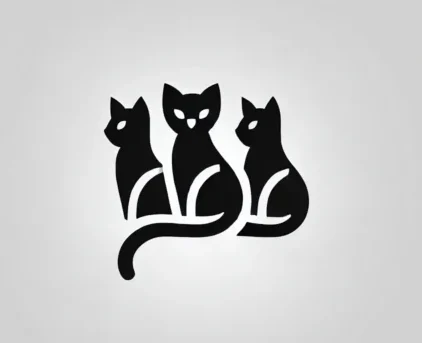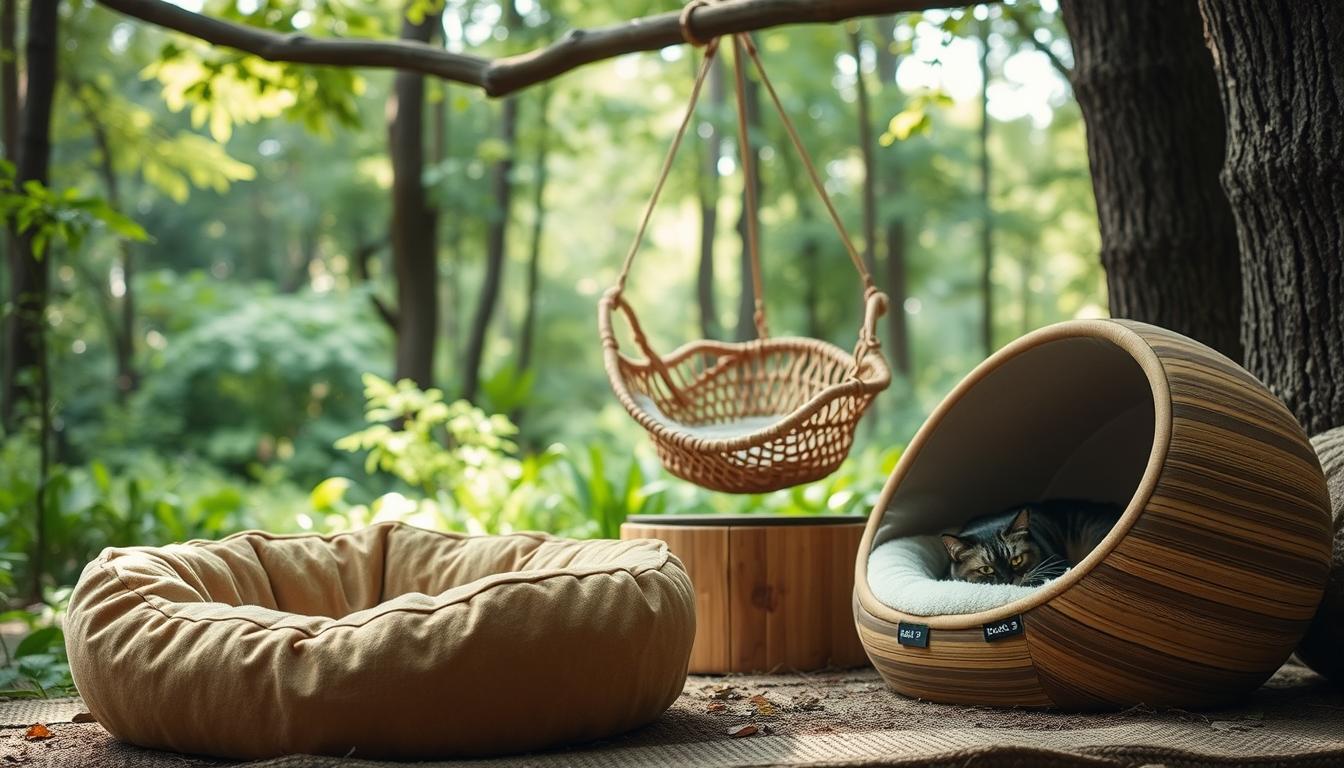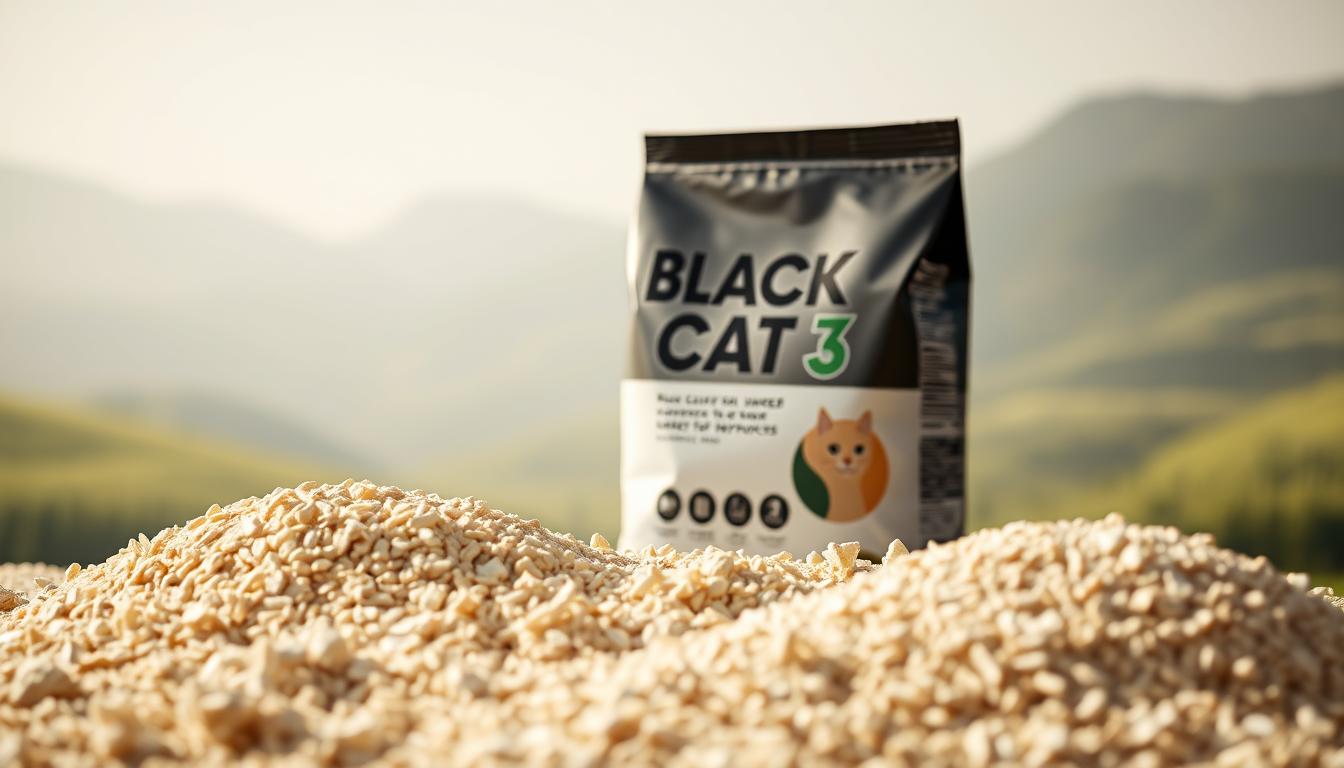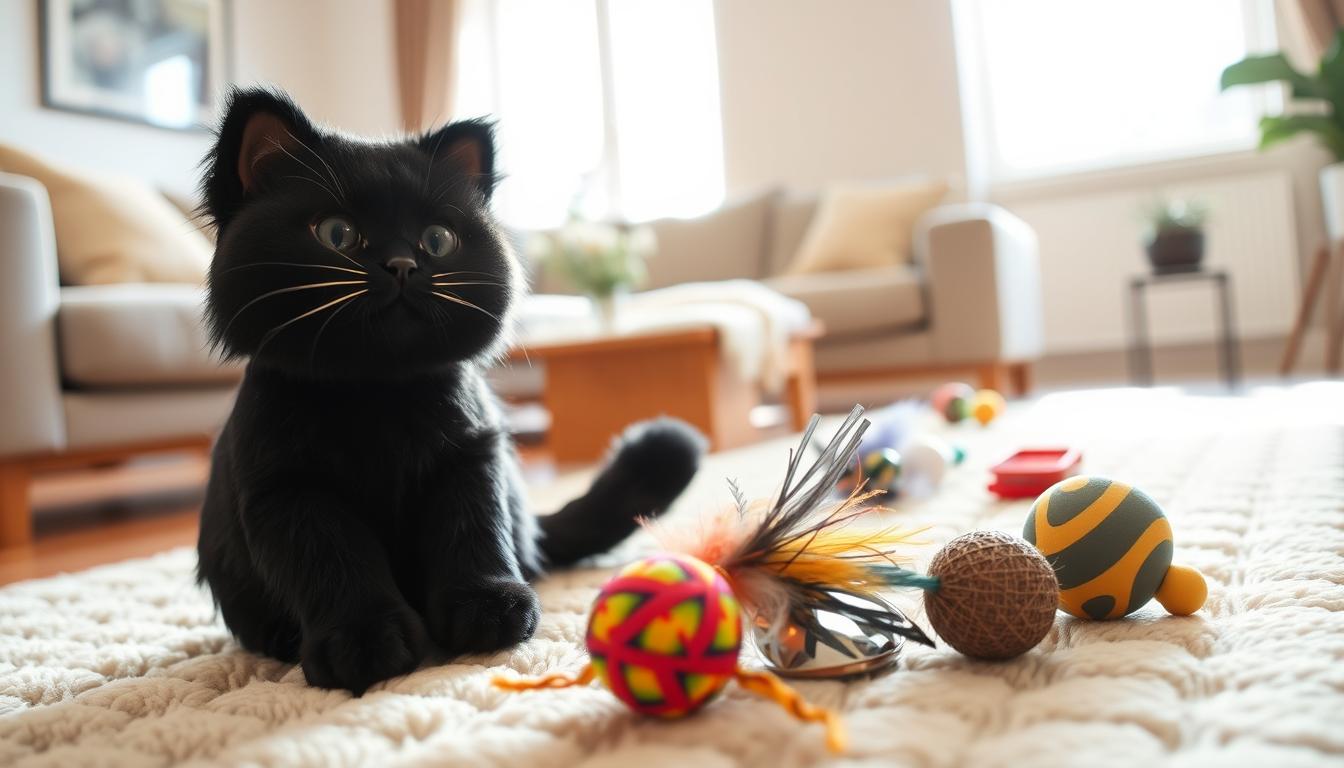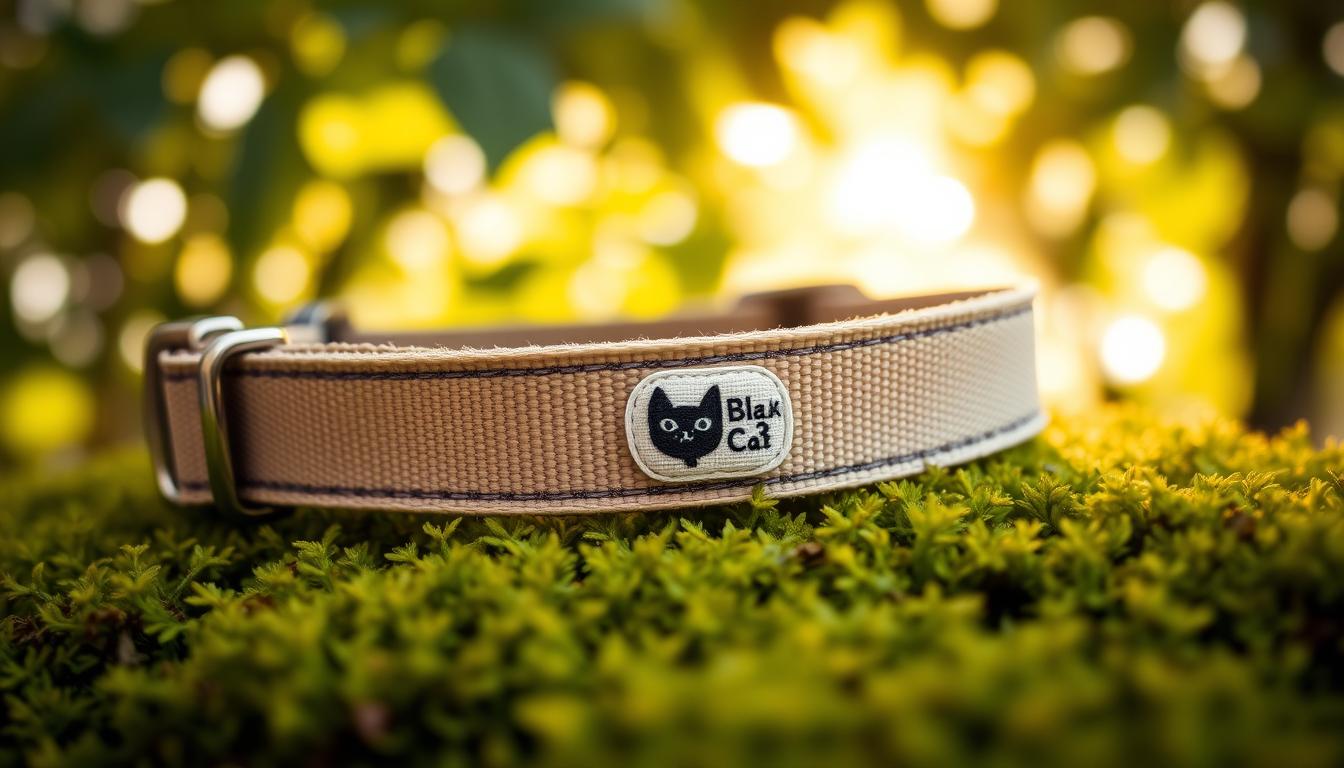Imagine a sunny afternoon. Your furry companion curls up in their favorite spot, purring softly. Now picture that same snug space also helping forests grow and oceans stay clean. That’s the magic of choosing a resting place designed with love—for pets and the Earth.
Many pet parents want comfort for their animals but worry about hidden costs to nature. A cat owner named Jamie shared, “My kitty deserves soft naps, but I don’t want plastic filling landfills.” This guide explores solutions, like the West Paw Heyday Bed, made from recycled bottles. These options keep claws safe and reduce waste.
Eco-friendly designs use natural fibers or reused materials. They’re easy to clean, last longer, and let cats snooze guilt-free. Learn how thoughtful choices—from cozy sleeping bags to sturdy mats—make happy pets and healthier ecosystems.
Key Takeaways
- Eco-conscious materials protect pets and reduce environmental harm.
- Popular brands like West Paw use recycled items for durability.
- Simple care routines keep these beds fresh and long-lasting.
- Safe, non-toxic options ensure feline comfort and safety.
- Every purchase supports a cleaner planet for future generations.
Introduction: Embracing Eco-Friendly Cat Beds
Every morning, Mia’s tabby paws at a fuzzy nest made from old sweaters. “He kneads like he’s baking bread,” she laughs. This cozy pet bed, crafted by a local artisan, shows how creativity meets care—for pets and the planet.
Traditional resting spots often hide plastics or harsh dyes. A vet once told Mia, “Soft surfaces shouldn’t whisper secrets of toxins.” Modern designs use natural fibers like organic cotton or hemp. These materials breathe better and last longer than synthetic fluff.
“My cat’s new cat cave feels like a hug from nature,” says Sarah, a teacher from Oregon. “She naps longer, and I sleep easier knowing it’s chemical-free.”
Even dog beds inspire feline-friendly upgrades. Recycled foam from car seats becomes plush cushions. Cork fabric, tough against claws, lines scratch-resistant loungers. These innovations prove comfort doesn’t need to cost the Earth.
| Material | Source | Benefit |
|---|---|---|
| Organic Cotton | Renewable farms | Hypoallergenic |
| Recycled Polyester | Plastic bottles | Reduces landfill waste |
| Hemp | Fast-growing crops | Naturally pest-resistant |
Choosing earth-conscious options helps forests thrive. One company plants a tree for every pet bed sold. Cats curl up, purring, while their naps fund cleaner air. It’s a win for whiskers and wildflowers alike.
Why Choose Sustainable Cat Beds? Environmental Benefits, Enhanced Comfort & Safety
When Luna’s owner found a resting place made from recycled soda bottles, the playful kitten didn’t notice the difference—just the cozy naps. “She kneads it like dough!” her human giggled. This clever creation turns trash into treasure, keeping 20 plastic bottles out of oceans for every cushion made.
Traditional pet beds often hide secrets. Some contain foam that takes 500 years to break down. Earth-conscious options use fluffy IntelliLoft® fill from reclaimed materials. Brands like West Paw craft these for both cats and dogs, making all furry friends planet helpers.
Why does this matter?
- Each recycled bed cuts carbon emissions by 30% compared to new materials
- Non-toxic dyes prevent itchy skin—1 in 3 cats show sensitivity to chemicals
- Hypoallergenic surfaces let even sneezy kitties breathe easy
“Our Heyday Bed survived three kittens’ zoomies,” shares dog bed designer Marco. “The machine washable cover stayed soft through 50 washes.” Easy care means less waste—no replacing torn fabric every few months.
“Choosing these materials feels like giving nature a thank-you hug,” says veterinarian Dr. Ellis. “Pets get safer naps, we get cleaner air.”
From snuggly caves to breezy loungers, these designs prove comfort doesn’t harm forests. Next time Whiskers curls up, imagine baby sea turtles swimming freely because their home stayed plastic-free. Sweet dreams for all!
Sustainable Cat Beds for Sale: What to Look For
At a local shelter, volunteers noticed something special—kittens favored nests made from reclaimed denim over plastic-lined cushions. “They choose what feels safest,” explained caretaker Clara. This instinct guides smart shopping for earth-friendly resting spots.
Seek out trusted certifications like OEKO-TEX®. These labels mean materials passed strict safety tests. B Corp status shows companies care for workers and nature. A bed with both marks? That’s a home run!
Durability matters. Check stitching on raised edges—double threads last longer. Removable covers simplify cleaning. Clara’s favorite? A hemp blend that survives weekly washes. “No fraying after six months,” she notes.
“Non-toxic fillings prevent allergic reactions,” advises vet Dr. Patel. “Always check certification tags first.”
Compare weight limits and fabric types. A recycled polyester cushion might suit playful climbers, while organic cotton suits sensitive paws. Remember: happy naps start with smart choices!
Material Matters: Eco-Friendly Fabrics & Fillings, Natural & Recycled Materials, Certifications: OEKO-TEX & More
At a neighborhood craft fair, eight-year-old Ellie marveled at a fluffy cushion woven from corn husks. “It’s like magic cornflakes!” she whispered, watching her tabby snuggle into the earthy-toned nest. This clever creation shows how everyday items become cozy resting spots through smart recycling.
Natural fibers like organic cotton breathe like fresh air. Wool from happy sheep stays warm without synthetic chemicals. Recycled polyester turns soda bottles into cloud-soft stuffing. These choices help cats nap safely while keeping trash out of rivers.
Look for the OEKO-TEX® tag—it’s like a superhero badge. It means no sneaky toxins hide in fabrics. The West Paw Heyday Bed wears this proudly, filled with IntelliLoft® made from plastic bottles. One bed saves enough bottles to fill a kiddie pool!
| Material | Eco-Perks | Kitty Benefits |
|---|---|---|
| Organic Cotton | Uses less water | Gentle on paws |
| Recycled Polyester | Reduces landfill waste | Hypoallergenic |
| Hemp | Grows fast | Scratch-resistant |
“Our rescue group only uses certified beds now,” says volunteer Mr. Thompson. “Kittens with sensitive skin stopped itching within days.”
These earth-smart materials last through countless washes and pounces. When Mittens curls up in her corn-husk throne, she’s not just napping—she’s helping butterflies find cleaner meadows. Sweet dreams for all creatures!
Designs and Styles to Suit Your Cat’s Instincts, Modern Cat Caves and Loungers
Mr. Whiskers, a fluffy Maine Coon, once ignored his sleek plastic bed for a cardboard box. His owner swapped it for a hemp-fiber cave, and now he peeks out like a tiny mountain lion. “It’s his throne,” laughs neighbor Lily. “He guards it like treasure!”
Enclosed cat caves tap into natural instincts. They mimic hollow trees or burrows, offering privacy during naps. Open loungers work for sun-loving kitties who sprawl like melted ice cream. Both options use materials like cork or organic wool—safe for kneading paws.
Modern designs blend with home decor. A recycled denim lounger matches rustic kitchens. Bamboo-framed beds add minimalist flair. “Our gray tabby’s bed looks like modern art,” says interior designer Carla. “Guests never guess it’s for pets!”
“The PurrfectPlay Sleeping Bag folds flat for travel—our adventure cat adores it!”
Raised edges on some pet beds create headrests. Others have removable cushions for easy washing. Whether Whiskers prefers jungle hideouts or sleek platforms, earth-friendly choices keep tails wagging and homes stylish.
Comparing Cat Bed Types: Caves, Loungers, and Sleeping Bags, Distinct Features of Each Style
In a cozy Brooklyn apartment, a curious kitten named Mochi tests three beds: a cave, a lounger, and a sleeping bag. “She’s the Goldilocks of naps,” her owner jokes. Each design whispers to different instincts—safety, sprawl space, or burrow-ready warmth.
Caves mimic hidden nooks, perfect for shy tabbies. Their enclosed shape feels like a hollow log. One Persian cat owner shared, “Mittens hides here during thunderstorms—her safe bubble.” Look for breathable hemp or organic cotton to prevent stuffiness.
Loungers suit sun-worshippers who stretch like starfish. Larger sizes fit Maine Coons, while compact versions work for sleek Siamese. A recycled polyester model survived three years of daily use by a 15-pound Ragdoll. “No sagging corners,” reports his human.
The PurrfectPlay Organic Cotton Sleeping Bag combines portability with coziness. Its foldable design travels well, and the chemical-free fabric won’t irritate sensitive noses. “Our adventure cat uses it in tents and hotel rooms,” says a hiking enthusiast.
“Always check for OEKO-TEX® labels,” advises groomer Tina. “Hidden chemicals in cheaper beds caused rashes on three clients’ pets last month.”
Small dogs sometimes steal these beds too! A Dachshund named Bean naps in his sister’s lounger. “They’re sibling rivals for the comfiest spot,” laughs their owner. Whether whiskered friends prefer secrecy or sprawling, earth-smart choices keep tails content.
Features to Consider in a Sustainable Pet Bed, Safety, Durability, and Cleanability
At a busy pet café, a golden retriever named Buddy kept stealing his feline friend’s new resting spot. “He thinks it’s indestructible!” laughed owner Clara. The bed’s tough microsuede bottom survived muddy paws and claw scratches—proof that smart design matters.
Look for machine-washable covers that simplify cleaning. One reviewer praised a hemp-blend bed: “Three washes later, it still looks new!” Tight stitching prevents filling from clumping, while non-slip bottoms keep playful pets grounded.
Natural wool isn’t just cozy—it’s nature’s thermostat. “My Persian cat stays warm in winter and cool in summer,” shared groomer Lisa. Reversible designs double usage; flip the cushion when one side gets worn.
“Always check for hidden zippers or loose threads,” advises vet Dr. Kim. “Safe beds protect curious paws from injuries.”
Before buying, test these features:
- Wipe-clean surfaces for quick mess removal
- Recycled polyester filling that holds shape
- Certifications like OEKO-TEX® for toxin-free materials
Eco-conscious brands often use carbon-neutral shipping, reducing harm to the environment. When naps meet thoughtful design, pets thrive—and forests do too.
The Eco-Credentials of Top Cat Beds, Certifications and Ethical Practices, Supporting Artisans & Sustainable Manufacturing
High in Nepal’s mountains, artisan Rajesh weaves soft products using wool from free-roaming goats. His hands shape cozy caves where kittens nap like tiny snow leopards. Each stitch supports his village’s school—proof that thoughtful craftsmanship changes lives.
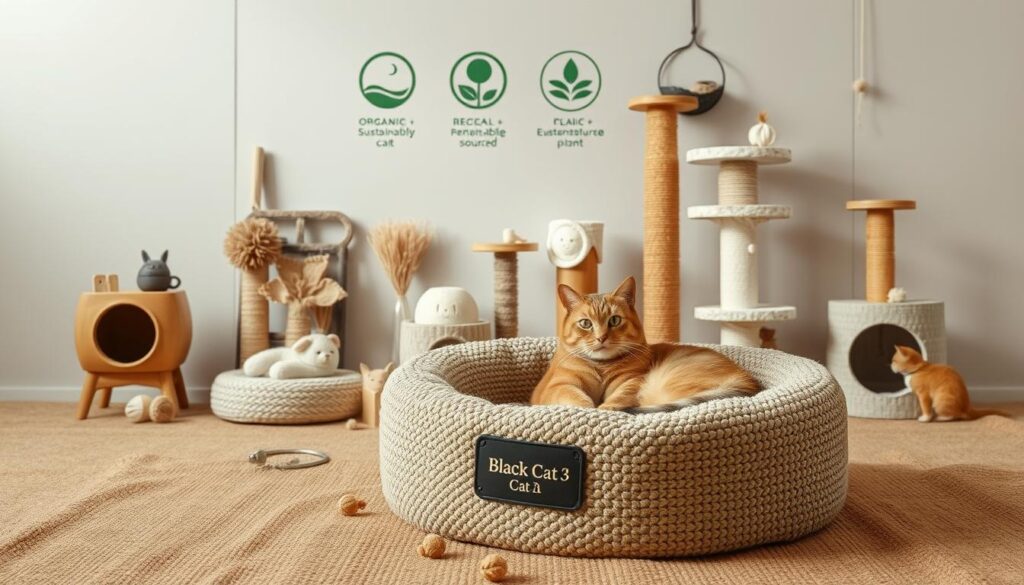
Trusted labels guide smart choices. The B Corp badge means companies meet strict social and environmental standards. OEKO-TEX® certification ensures fabrics won’t irritate delicate fur. Together, they create safer napping spots and healthier ecosystems.
| Certification | What It Means | Impact |
|---|---|---|
| B Corp | Fair wages, eco-friendly practices | Supports worker families |
| OEKO-TEX® | Zero harmful chemicals | Protects skin and lungs |
| Fair Trade | Empowers small communities | Funds schools and clinics |
Rajesh’s workshop uses natural dyes from turmeric and indigo. “We sing while carding wool,” he shares. “The products carry our care.” Choosing these items helps preserve ancient skills while keeping toxic dyes out of rivers.
“Every purchase feeds three children in our village for a week,” explains Rajesh’s daughter Anjali. “Your kitty’s bed builds futures.”
Soft materials matter beyond comfort. Organic cotton prevents rashes on sensitive bellies. Hemp fibers resist mold—a lifesaver for pets with allergies. When Whiskers curls up in her earthy cave, she’s wrapped in safety and hope.
These choices whisper a powerful truth: cozy naps can heal both fur and forests. Next time your feline friend purrs in their nest, remember the mountainside looms humming with gratitude.
Detailed Reviews of Popular Eco-Friendly Cat Beds, West Paw Heyday Bed Overview, PurrfectPlay Cat Sleeping Bag Insights
In a sunlit Colorado living room, a rescued tabby named Pumpkin tests two earth-friendly napping spots. “She rotates between them like a tiny nap critic,” her owner chuckles. Let’s explore why these home favorites earn whisker-approved status.
West Paw Heyday Bed: Plastic Bottles Turned Paradise
This cushion transforms 12 recycled bottles into cloud-like fluff. Its IntelliLoft® filling stays springy even after nightly kneading sessions. Machine washable covers handle muddy paw prints—just toss it in cold water.
“Our three-legged kitty stopped slipping on the non-skid bottom,” shares Rhode Island teacher Ms. Wu. “She naps here 5 hours a day!”
PurrfectPlay Organic Cotton Sleeping Bag: Adventure-Ready Snuggles
Handstitched by Montana artisans, this portable nest folds into backpacks. Organic cotton lining breathes during summer hikes. “It’s our feature during camping trips,” says outdoorsy cat dad Ryan. “No more pine needles in his fur!”
| Product | Material | Key Feature | User Feedback |
|---|---|---|---|
| Heyday Bed | Recycled polyester | OEKO-TEX® certified | “Survived 2 kittens!” |
| Sleeping Bag | Organic cotton | Foldable design | “Washes like new” |
Both options prove cozy spots don’t harm forests. Pumpkin’s owner notes, “Within 3 days, she claimed both as her throne.” Thoughtful designs mean happy pets and cleaner parks—one nap at a time.
Assessing Durability and Ease of Cleaning
At a community garden event, young Liam watched his kitten Pebbles test a new resting spot. “She digs like she’s planting carrots!” he giggled. The sturdy cotton fabric held strong against tiny claws—proof that thoughtful design protects both naps and nature.
Why does durability matter? A well-made nest survives years of pounces and naps. Microsuede surfaces wipe clean with a damp cloth, while organic cotton covers handle weekly washes. “Our dog’s bed still looks new after two years,” shared Liam’s mom. “It matches our living room furniture perfectly!”
“Machine-washable designs save time and money,” says animal shelter volunteer Rosa. “We reuse them for many furry friends over the years.”
Simple care keeps homes fresh:
- Spot-clean muddy paw prints with mild soap
- Air-dry covers to prevent shrinking
- Rotate cushions to avoid flat spots
Tough materials protect more than pets. Scratch-resistant bottoms guard hardwood floors and sofas. When furniture stays safe, families avoid buying replacements—reducing landfill trips.
| Material | Cleaning Tip | Lifespan |
|---|---|---|
| Organic Cotton | Cold wash, gentle cycle | 5+ years |
| Microsuede | Wipe with vinegar solution | 3-4 years |
| Recycled Polyester | Tumble dry low heat | 4-5 years |
Liam’s family learned that quality choices help everyone. Their old plastic mat tore within months, but the new cotton bed remains Pebbles’ favorite. “She shares it with her bunny friend sometimes,” he whispers. “They take turns being king of the mountain!”
Price Range, Value, and Shipping Considerations, Cost Analysis and Budget Options
At a weekend farmers market, young Zoe tugged her dad toward a vendor’s display—a plush resting spot made from upcycled denim priced at $49. “It’s softer than my blanket!” she declared. This mid-range option balances quality and cost, showing how thoughtful design meets real-world budgets.
Basic recycled fleece mats start around $45, perfect for families watching expenses. Premium choices, like organic wool caves, can reach $279. Materials matter: hemp blends last longer than cotton but cost 30% more. “Our West Paw bed survived three years of daily use,” shared a Maine Coon owner. “Worth every penny!”
| Product | Price | Key Feature | Shipping |
|---|---|---|---|
| Denim Dream Mat | $44.95 | Machine-washable | $8 flat rate |
| Mountain Wool Cave | $279 | Handfelted fibers | Free over $150 |
Shipping adds hidden costs. Many U.S. brands offer $12 flat rates—a steal for heavy items. International orders face higher fees, but companies like PurrfectPlay offset carbon emissions. “Our blanket-soft bed arrived in 2 days,” said a Canadian buyer. “No surprise charges!”
“Bigger size means better value,” notes eco-designer Clara. “A $120 lounger fits cats and small dogs—cheaper than buying two separate beds.”
Smart shoppers compare long-term benefits. A $75 machine-washable option saves $100 in cleaning fees over five years. Whether choosing budget-friendly or luxury, every earth-conscious nap supports greener futures.
Additional Eco-Friendly Pet Products and Accessories, Expanding Your Sustainable Pet Collection
In a sunny classroom, students crafted chew toys from old T-shirts. “Biscuit loves his new rope!” beamed 10-year-old Mia, holding a braided creation. This project sparked ideas for earth-friendly pet spaces beyond resting spots—like hemp duvet covers and wool blankets that complete cozy habitats.
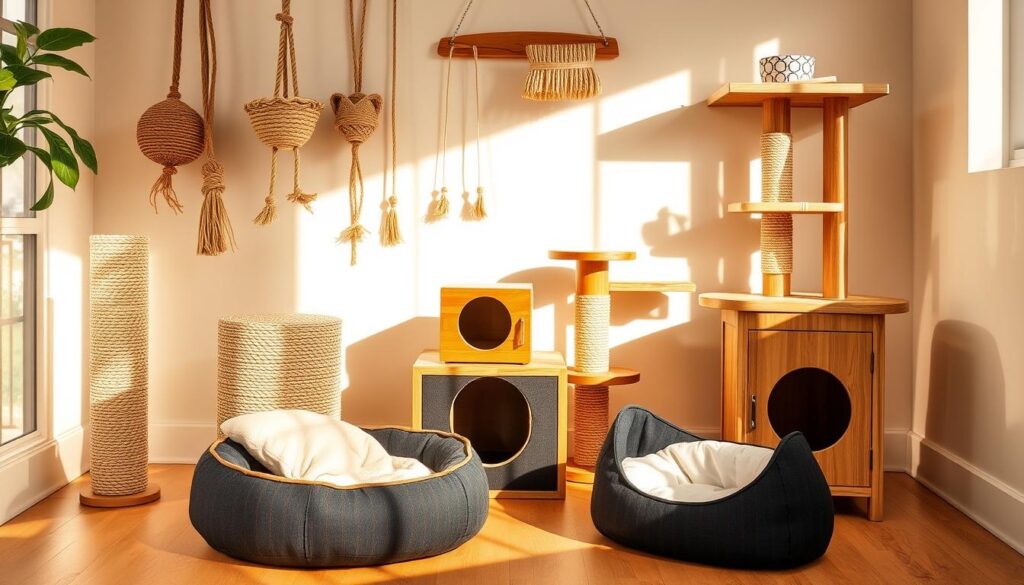
Pairing a Hemp Canvas Dog Bed Duvet with organic cotton cushions creates layered comfort. The tough fabric resists scratches, while natural fibers breathe during summer naps. For chilly nights, a Wool Cat Cave offers warmth without synthetic fillings. “Our rescue pup’s bedding set survived three wash cycles,” shared foster parent Diego.
“Matching accessories turn pet corners into eco-sanctuaries,” says artisan Lena. “We use plant dyes for color—think beetroot reds and spinach greens.”
Thoughtful design extends to playtime too:
- Recycled rubber balls bounce like new
- Felt mice stuffed with catnip grow herbs when composted
- Bamboo feeding bowls complement neutral-toned beds
| Product | Material | Style Benefit |
|---|---|---|
| Hemp Duvet | Organic hemp | Earth tones blend with decor |
| Wool Blanket | Ethical wool | Adds texture contrast |
Choosing cohesive color schemes—mossy greens, warm browns—helps pet areas feel calm. A Maine Coon owner noted, “The natural palette matches our living room, so Fluffy’s bed looks like design furniture.”
Every eco-accessory supports cleaner ecosystems. When pets play with corn-fiber toys or nap on cork mats, they join a movement where joy nurtures the planet. Small choices weave big stories—one wagging tail at a time.
Expert Tips for Encouraging Your Cat to Use Their New Bed, Optimal Placement and Familiarity, Incorporating Catnip & Toys
Have you ever placed a cozy spot for your feline, only to find them napping in a cardboard box instead? “Cats choose comfort on their terms,” explains animal behaviorist Dr. Lee. With a few thoughtful tweaks, even the pickiest whiskered friend will adore their new nest.
Start by choosing the right room. Place the bed where your animal companion already spends time—like a sunny corner or near their favorite window. A quiet space with low foot traffic helps shy pets feel secure.
“Sprinkle organic catnip on the bed’s surface,” suggests groomer Tina. “The scent acts like a welcome mat for curious noses.”
Familiarity matters. Add a soft blanket your pet already loves, or gently rub their scent onto the material. This creates instant recognition. For multi-cat homes, place beds in separate areas to avoid competition.
- Use toys to spark interest—dangle a feather wand over the bed during play
- Reward with treats when they explore the new spot
- Avoid moving the bed once your animal claims it
Natural materials like organic cotton or hemp feel safer than synthetic fabrics. One Maine Coon owner shared, “Switching to a wool-blend bed made all the difference—Mr. Whiskers now naps there daily!”
Patience pays off. Let your feline friend investigate at their own pace. Soon, their new bed will become the purr-fect retreat—for them and the planet.
Environmental Impact: Minimizing Your Cat’s Carbon Pawprint
During a school science fair, fifth-grader Emma asked, “Does Fluffy hurt the planet?” Her question sparked a family mission to shrink their tabby’s environmental pawprint. Small changes, like picking earth-friendly toys and reusing shipping boxes, added up fast.
Pet product factories create 12% of global plastic waste yearly. Shipping orders across countries releases greenhouse gases too. Choosing local brands cuts transportation miles. “We buy catnip mice made from recycled denim now,” Emma’s mom shared. “They’re sturdier than plastic ones!”
“Every reused cardboard box becomes a free playhouse,” says eco-vet Dr. Rivera. “Cats love simplicity—save money and trees!”
Try these easy steps:
- Combine orders to reduce delivery trips
- Pick toys with natural dyes or hemp strings
- Repurpose glass jars as treat containers
| Product | Traditional Choice | Eco Swap | Impact |
|---|---|---|---|
| Scratching Post | Plastic base | Cork + reclaimed wood | Saves 3 lbs of plastic |
| Catnip Toy | Polyester stuffing | Organic cotton + homegrown herbs | Zero waste |
| Food Bowl | Disposable plastic | Bamboo or stainless steel | Lasts 10+ years |
Emma’s family now wraps gifts in old pet food bags. Fluffy bats around paper scraps instead of store-bought balls. Tiny choices, big difference—for frisky felines and fresh air alike!
Sustainable Cat Bed Buyer’s Guide Recap, Key Takeaways
In a quiet library corner, a calico kitten curled up on a cushion stitched from recycled jeans. “She naps here while I read,” whispered caretaker Mrs. Gomez. “It’s our little secret for care that lasts.” This moment captures why thoughtful choices matter—for paws and planet alike.
Key features to remember:
- Organic cotton and hemp resist wear while being gentle on paws
- OEKO-TEX® certified fabrics ensure safety during nap time
- Machine-washable designs simplify cleaning routines
“Our wool cave bed still looks new after three years,” shares cat dad Carlos. “That’s time well spent!”
Ethical manufacturing makes a difference. Brands using Fair Trade practices support artisan communities. Recycled polyester fills cushions while keeping plastic out of oceans. These choices show care for ecosystems and future generations.
| Feature | Benefit | Example |
|---|---|---|
| Natural Fibers | Breathable comfort | Organic cotton loungers |
| Certified Materials | Non-toxic surfaces | West Paw Heyday Bed |
| Recycled Fill | Reduces waste | Bottle-stuffed cushions |
Simple steps create big change. Choose beds matching your cat’s habits—caves for privacy seekers, mats for sunbathers. Regular cleaning extends their lifespan, saving time and money. Every cozy nap becomes a vote for greener tomorrows.
Conclusion
In a small town’s community center, children giggled as kittens snuggled into nests woven from recycled sweaters. Their laughter carried a quiet truth: every cozy choice whispers kindness to both pets and the planet.
Earth-friendly resting spots blend safety with softness. Materials like premium felt cradle claws gently, while breathable fibers keep naps toxin-free. A cat bed cave crafted from organic wool offers privacy, mimicking natural hideaways without harming forests.
Responsible pet parenting means thinking beyond today’s purrs. When you shop for items like hemp loungers or cork-lined mats, you vote for cleaner oceans. These choices let felines thrive while protecting habitats for birds and bees.
Consider a premium felt cat sleeping bag for adventure-loving companions. Its foldable design travels well, and plant-based dyes ensure playful nibbles stay safe. Every purchase supports artisans who prioritize ethical practices.
Let your next cat bed cave be more than a nap spot—make it a promise. A vow to cherish furry friends and blooming meadows equally. Because when whiskers twitch in contentment, the Earth smiles too.
